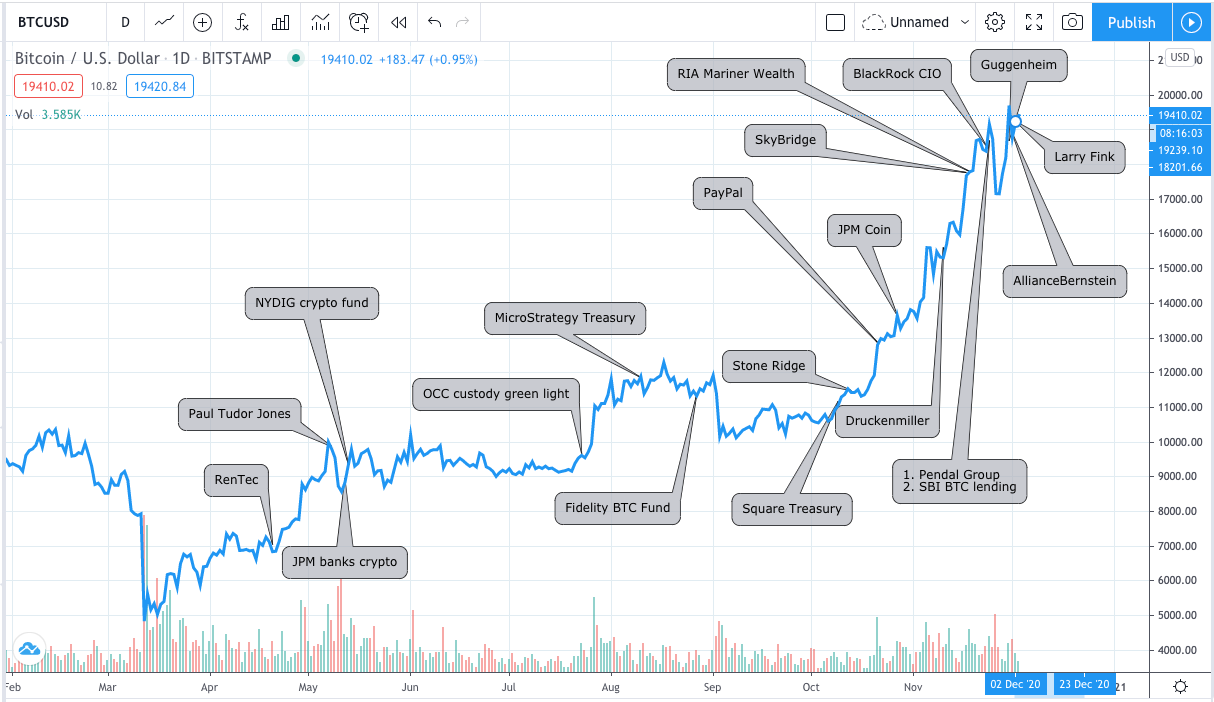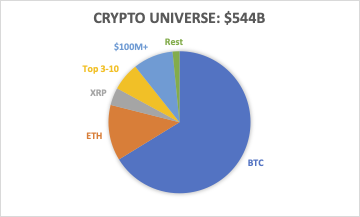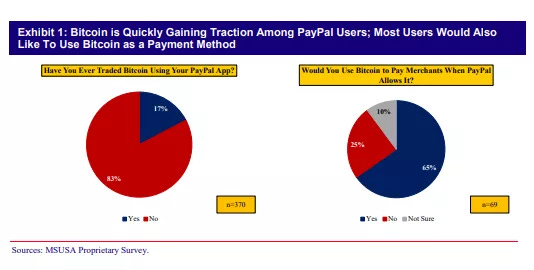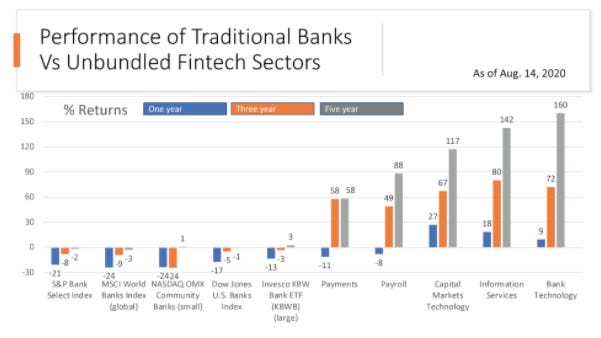
Another week where institutional momentum continued to build across the board. This against the backdrop of a bitcoin recovery from a short-term dip and breaking through its all time high. Let’s see if December will be magic again and bring us $20,000!
In this issue:
- The institutions are causing a stir…
- …now what?!
- A lot of Coinbase, for better and for worse
And: other interesting news, CBDC and stablecoin highlights, food for thought top picks, the big picture, quotes of the week.
Top story
Visa says it’s connecting its global network of 60M merchants to Circle’s USDC
- Businesses will eventually be able to send international USDC payments to any business supported by Visa, and after those funds are converted to the national currency, spend them anywhere that accepts Visa.
- “We continue to think of Visa as a network of networks,” said Visa’s head of crypto. “Blockchain networks and stablecoins, like USDC, are just additional networks.”
- Visa estimates that $120T in payments annually are made using checks and instant wire transfers, costing as much as $50 each, regardless of the size of the transaction. Since USDC settles on the ethereum blockchain, transactions can close in a little a[s] 20 seconds and, importantly, can be done for nearly free.
- I may be missing something here, but it reminds me of what JPMorgan is trying to do for its multinational corporate clients with the JPM Coin. The article is worth a read as it gives a lot of insight into what Visa is trying to do with crypto.
- The Centre Consortium that oversees the USDC stablecoin announced earlier this week that it hired Wall Street veteran David Puth as its first CEO.
Trend Follower: Connecting the Dots
The institutions are causing a stir …
More crypto converts this week and a lot of “the institutions are here” buzz (sounds familiar?) — see below for the headlines. We already discussed how “this time it’s different” so let’s have a look at how institutional momentum has built up over the course of 2021. It started out with a few quarterly headlines which then grew to monthly, weekly, and finally almost daily headlines in the present. It will be interesting to see how this will develop in the months to come.

- AllianceBernstein now says bitcoin has role in investors’ portfolios.
- BTIG says crypto ‘comes of age,’ puts $50K 2021 target on BTC.
- $275B+ hedge fund Guggenheim considers $500M bitcoin investment.
- NYDIG raises $150M for two Bitcoin investment funds from 3 investors.
- BlackRock CEO Larry Fink says Bitcoin is gaining legitimacy as an asset class.
…now what?!
So traditional institutions (hedge funds) are starting to play in bitcoin. Interestingly, the larger funds (the ones in the headlines) seem to gain exposure mainly through “indirect” and regulated channels, like Grayscale and CME futures. IMO this is a reflection of the operational risk (custody, unknown territory, new infrastructure, etc.) they would be taking relative to what they see as the current “investable” opportunity. What I mean by that is that the overall size of the crypto market remains small and there is a lack of diversity in terms of investment opportunities when you look at it at scale.
Let’s look at the composition of the universe ex-stablecoins (data source: Messari — check out their new interface).

There are 105 assets with a market cap of $100M+ that make up 98.4% of the total market cap, with the top 2 roughly making up 79% of the universe. Compare that to “smallish” sub-asset classes with distinct investor bases: convertible bonds at $380B and 750 issues and high yield at call it $2-2.5T and 3K+ issues (I couldn’t find 2020 data). There are obviously many other considerations (including quality), but you see what I mean? There are just not enough opportunities in the market right now for larger investors to make sizable allocations and stick within risk limits (i.e. not more than 10% of market cap, minimum liquidity, concentration, etc.). And with the positive prospects for bitcoin, a portfolio diversification strategy (allocate a small percentage of assets to BTC) probably makes most sense at this stage.
I do think 2021 will bring many positive things for crypto that will set the stage for the above to change starting in 2022. I will share my predictions for 2021 next week.
A lot of Coinbase, for better and for worse
- It started last Thursday with more technology problems “Coinbase hit by connection, latency problems as bitcoin plummets,” and yet more on Monday, “Coinbase delays in processing BTC Withdrawals due to network congestion”. We covered this a few weeks back but they seem to have a lot of issues recently.
- The next day, the NYT ran a story “‘Tokenized’: Inside Black Workers’ Struggles at the King of Crypto Start-Ups” which CEO Brian Armstrong front-ran in a blog post.
- On Monday, the exchange said that it will support Ethereum 2.0 in early 2021, let users convert ETH into ETH2 and earn staking rewards.
- Followed by another announcement Tuesday “Coinbase to incentivize market makers for improving the liquidity of less liquid trading pairs.”
- That same day the firm reported in a blog post that it enabled MicroStrategy’s $425M Bitcoin purchase. There is a link to a case study. A lot of banker talk but interesting nevertheless. The initial $250M investment was executed over the course of 5 days spanning nearly 200K child orders.
- The week was topped off with a book “When Coinbase met Cantor Fitzgerald.”
Other interesting news
- Both Copper and Fireblocks announced DeFi solutions that offer secure, enterprise-grade, and easy access for organizations. “This allows investors to lock their assets into DeFi ‘smart contracts’ and tap into the liquidity currently locked in DeFi, valued at more than $14B.”
- BlockFi is partnering with Visa to launch a bitcoin rewards credit card next year.
- Almost 20% of PayPal users have used the app to trade bitcoin, Mizuho says.

CBDC Highlights
- ECB Board Member outlines four topics for digital euro trials. (1) can the current central bank settlement system support 100s of millions of customers; (2) interoperability with centralized systems; (3) use of payment-dedicated blockchains with electronic identity; (4) hardware devices for offline transactions that guarantee privacy.
- China’s digital currency could reshape Macau’s gambling industry. Insiders say that the imposition of a traceable, government-linked currency will be the death knell for Asia’s Las Vegas, already hobbled by the virus’s impact and stricter rules around high-stakes gambling over the past few years.
Cousin stablecoin had an interesting week too. In addition to USDC’s news:
- Head of ECB Christine Lagarde is concerned about stablecoins which could “pose serious risks.” “If widely adopted, they could threaten financial stability and monetary sovereignty. For instance, if the issuer cannot guarantee a fixed value or if they are perceived as being incapable of absorbing losses, a run could occur. Additionally, using stablecoins as a store of value could trigger a large shift of bank deposits to stablecoins, which may have an impact on banks’ operations and the transmission of monetary policy.”
- US lawmakers introduced a bill that would require stablecoin issuers to obtain bank charters. Circle’s Jeremy Allaire shared his opinion.
- Libra rebranded to Diem, a scaled-back version that could launch as early as January.
Food for thought top picks
How Unbundling and Decentralization Are Reshaping Banking and Financial Services. Acting OCC Comptroller Brian Brooks notes that the financial performance of traditional banks has been flat to negative in recent years compared to stellar performance by unbundled FinTech services.

Reasons for the contrast include a near zero interest rate environment and legacy infrastructure costs. However, more fundamentally, the tandem force of unbundling and decentralization is reshaping the banking and financial industries. The OCC is working to make sure that the US banking system is ready for this evolution and that as many people benefit from these changes as possible.

Crypto wallets are not bank accounts. AVC’s response to last week’s threat by the US Treasury to regulate crypto wallets. AVC argues that:
“Regulators need to think of crypto wallets like web browsers. They are software applications that open up access to the decentralized internet and over time they will reduce our reliance on applications like Facebook, Google, Amazon, etc. But only if they are allowed to exist without crushing regulation, like we treated the web browser when it came out in the mid 90s.”
NFTs: a revolution for digital capitalists. As the NFT market breaks out, devs are feverishly designing platforms that use NFTs in innovative and surprising ways. Trading volume for the NFT market surged 57% over summer 2020, pushing the worth of the industry to about $100 million. New NFT platforms are enabling fractionalized ownership of digital assets such as artwork. DeFi platforms are starting to use NFTs to act as collateral for loans or derivatives.
The Big Picture
The World’s Appetite for Debt Is Smashing Records. Companies and governments have issued $9.7 trillion of debt this year. US investment grade issuance is up 54% YOY and high yield 70%. The latter is a reflection of investors’ willingness to go down the risk spectrum to make up for a low yield environment. In the longer term, however, high debts could increase financial fragility. The IIF says it isn’t clear how global debt levels can be brought back down without significantly hurting economic activity.

Bitcoin’s Rally Spurs Wall Street to Question the Future of Gold.
Bitcoin has shot to a record just as billions of institutional dollars have fled gold. The debate is now heating up on whether bitcoin can one day rival bullion as an inflation hedge and portfolio diversifier. If mainstream investors start moving just a small portion of their gold holdings into bitcoin, it would be a game-changer for diversification strategies on Wall Street. “Gold was really the safe asset of the past world and baby boomer generation. Now it’s being replaced by automated assets like Bitcoin.”
BlackRock’s CIO recently commented that trading bitcoin “is so much more functional than passing a bar of gold around” and that it is “here to stay” backed by strong demand from millennials.
Sanford Bernstein’s Inigo Fraser-Jenkins said in an interview “I see it as being complementary. Whatever one’s starting position was before the pandemic in terms of what your gold and crypto allocation should be, I think it should be materially larger now.”
Quote of the week
Closing in on more Corporate Treasury investment in bitcoin
Raoul Pal said that the reason many companies haven’t invested in bitcoin is because the corporate treasurer needs to justify [to shareholders] putting firm assets into crypto.
The Treasurer “needs some piece of paper written by an investment bank or somebody with credibility that says this is a really good diversification asset that adds overall value to your portfolio. The moment that kind of research comes out — and there is some of it coming out — that will completely shift the game.”
You might get fired if you don’t own Bitcoin
CoinShares’ Danny Masters said on CNBC Power Lunch:
“Perceived career-risk for having Bitcoin in your institutional portfolio, as a portfolio manager, is fast migrating into a career-risk for not having Bitcoin in your portfolio, and that’s a really stunning development.”
Disclaimer: any views expressed are my own and do not represent the views of my employer. The content in this newsletter is based on information from publicly available sources.

